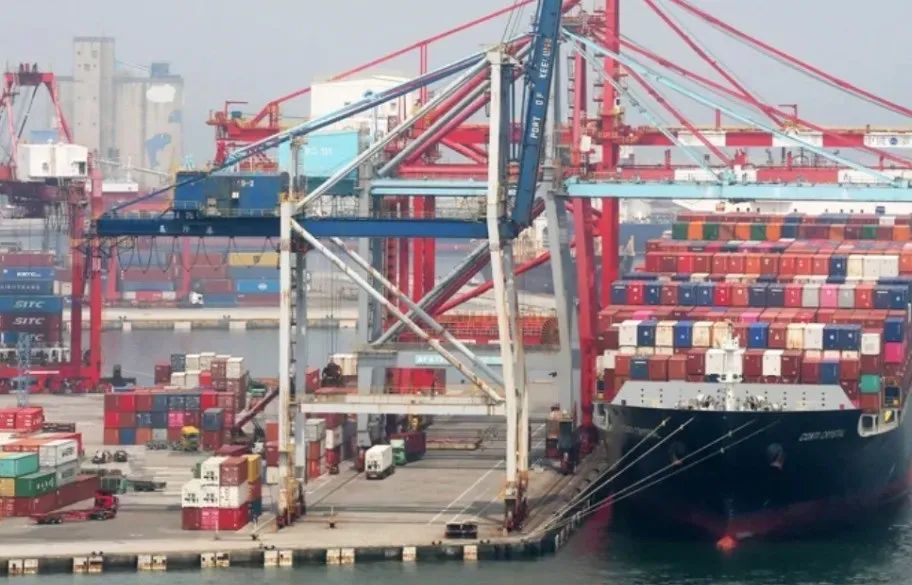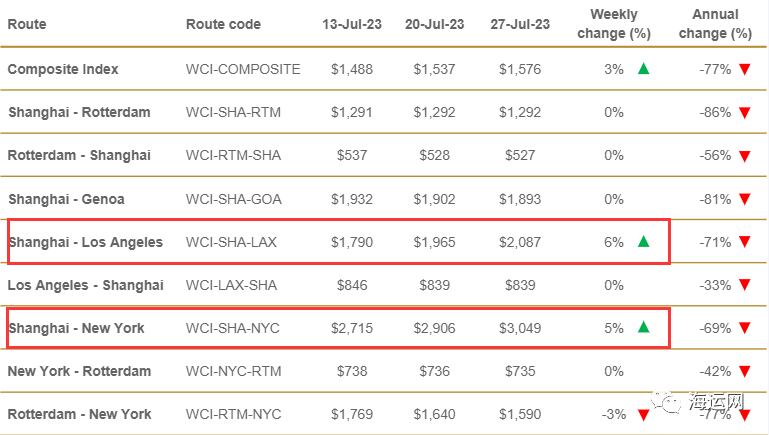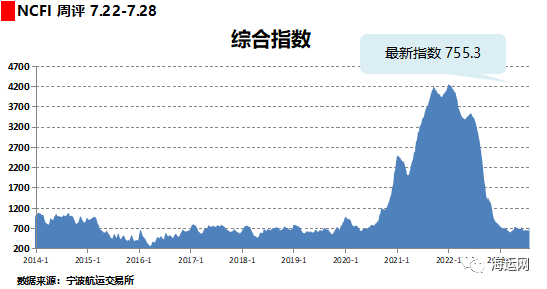European and American freight rates are rising together! The European line surged by 30%, while the US and West rose by another 10%
The industry has revealed that with limited increase in cargo volume in Europe and the United States and continuous investment in new capacity, shipping companies are approaching the limit of reducing shipments. Whether to maintain the upward trend of freight rates in the first week of August will become an important observation focus.

Industry insiders believe that the actual increase in the first week of August and how long it can be sustained remain to be seen. With the delivery of a large number of new ships, shipping companies will face significant challenges. However, the industry leader Mediterranean Shipping's capacity growth in the first half of this year was as high as 12.2%, and its trend has attracted much attention.
Shanghai Shipping Exchange SCFI Latest Index:
The freight rate from Shanghai to the West United States is 1943 US dollars/FEU, an increase of 179 US dollars or 10.15%;
The freight rate from Shanghai to the East United States is $2853/FEU, up $177 or 6.61%.
European route: The initial value of the Markit composite PMI for the Eurozone in July dropped to 48.9, lower than the previous value and market expectations, reaching the lowest level since November last year, marking the second consecutive month below the boom bust line of 50. The future prospects for economic recovery in the European region are not optimistic. This week, transportation demand has performed well, and the supply and demand fundamentals have improved. Airlines have implemented price increase plans, driving up market freight rates significantly.
The freight rate from Shanghai to Europe is $975/TEU, an increase of $233 or 31.40%;
The freight rate from Shanghai to the Mediterranean increases by $96 or 6.61% for every $1503/TEU;
The freight rate per container on the Persian Gulf route is $839, a significant decrease of 10.6% compared to the previous period;
The South American line (Santos) has a freight rate of $2513 per box, a weekly decrease of $67 or 2.60%;
The Southeast Asian line (Singapore) charges $143 per box, a weekly decrease of $6 or 4.30%.
The industry indicates that this surge is entirely driven by the will of shipping companies to turn the tide. The shipping industry is experiencing a peak in new ship delivery, with the capacity of new ships continuously accumulating since March. In June, the global new capacity reached nearly 300000 TEUs, setting a new monthly high. Entering July, the cargo volume in the United States has gradually increased, while the cargo volume in Europe has slightly improved. However, it is still difficult to digest excess capacity and there is an imbalance between supply and demand. The main reliance is on shipping companies to reduce classes and stabilize freight rates. There are rumors in the market that the current withdrawal rate is approaching a critical point. Especially on European routes where many 20000 TEU newly built large ships have been launched.
The freight forwarder stated that many clearance ships at the end of July and beginning of August have a loading rate that is not yet full, and whether the price increase of the shipping companies on August 1st can hold up and not fall back will test whether the various shipping companies have a tacit understanding and are willing to sacrifice loading rates and jointly maintain freight rates.

The industry pointed out that the significant decline in freight rates on the European and American routes, approaching or falling below the cost line, has strengthened the determination of shipping companies to raise prices. In addition, during the period of low prices in the US shipping industry, many small and medium-sized shipping companies were forced to withdraw, and US shipping prices began to stabilize. With the gradual increase in US cargo volume in June and July, prices successfully increased.
Subsequently, European shipping companies will replicate the experience of the US route to the European route. Although there has been an increase in cargo volume on the European route recently, it is limited. The duration of the upward trend still depends on market supply and demand.
The latest Deloitte WCI index:
The increase in GRI, strikes at Canadian ports, and capacity cuts have all had a certain impact on US freight rates. The latest WCI trend shows:
The Shanghai Los Angeles (US West Route) freight rate broke through the $2000 mark and closed at $2072. The last time this freight rate appeared on this route was six months ago.
The freight rate from Shanghai to New York (US East route) also exceeded the $3000 mark, rising 5% to close at $3049, once again reaching a six month high.
The East and West of the United States have driven the Delaware World Container Index (WCI) up 2.5% to reach a level of $1576. Over the past three weeks, WCI has risen by $102 (approximately 7%).

The latest BCFI index of Ningbo Shipping Exchange:
The Ningbo Export Container Freight Index (NCFI) closed at 755.3 points, up 16.2% from last week. Out of the 21 routes, 15 routes have seen an increase in their freight index, 4 routes have seen a decrease in their freight index, and 2 routes have remained relatively stable in their freight index. Among the major ports along the Maritime Silk Road, 8 of them have seen an increase in freight rates, while 8 have seen a decrease in freight rates. 
North American routes: The market has entered a traditional peak season, and with the support of increased freight demand and active regulation of available market capacity by liner companies, route fares have significantly increased since August.
European routes: Cruise companies have collectively increased the freight rates for routes starting after August, resulting in a significant increase in the market freight rates for European routes. Among them, the weekly increase in freight rates on European routes is the largest since 2019.
Middle East route: The market supply and demand relationship has not improved, and spot market booking prices have slightly decreased this week. The Middle East route index is 648.7 points, down 1.3% from last week.
In addition, the following routes have experienced significant market fluctuations this week:
Australia New Zealand route: The market shipment volume has increased, and the cabin space on the route was tight in early August. The liner companies have pushed up freight rates, resulting in a significant increase in spot market booking prices. The freight index for the Australian New Zealand route was 529.65 points, an increase of 26.7% from last week.The freight index for European routes was 724.7 points, up 56.9% from last week;
The fare index of the eastern route was 829.2 points, an increase of 18.8% from last week;
The freight index of the Dixi route was 980.9 points, an increase of 20.7% from last week.
The freight index for the US East route was 1035.5 points, an increase of 12.7% from last week;
The freight index for the US West route was 1158.7 points, an increase of 15.2% from last week.- According to Alphaliner statistics, the shipping industry is experiencing a frenzy of new ship deliveries. In June of this year, the global container ship capacity delivered was close to 30 TEUs, setting a new monthly high, with a total of 29 ships delivered, almost averaging one ship per day. Since March this year, the delivery capacity of new ships has continued to rise, and it will remain at a high level both this year and next year.
- According to Clarkson's data, a total of 147 container ships delivered 975000 TEUs in the first half of this year, an annual increase of 129%. Clarkson predicts that global container ship deliveries will reach 2 million boxes this year, and the industry estimates that the peak delivery period may continue until 2025.
- According to Alphaliner statistics, among the top ten container shipping companies in the world, the highest increase in capacity in the first half of this year was achieved by Star Line, ranked tenth, with a growth rate of 13.3%. The second highest increase in capacity was achieved by Mediterranean Line, ranked first, with a growth rate of 12.2%. The third highest increase was achieved by Japan Ocean Network Shipping, ranked seventh, with a growth rate of 7.5%; Evergreen Shipping has built many new ships, but the growth rate is only 0.7%. Yangming Shipping's capacity has decreased by 0.2%, Maersk has decreased by 2.1%, and the industry estimates that many ship leasing contracts have been terminated,
- Industry insiders point out that in the context of overcapacity in the market, can shipping companies maintain sufficient tacit understanding? Is it possible to implement the reduction of ship schedules for a long time? Can we hold onto the freight rate and not bargain for goods? It will take time to prove.




